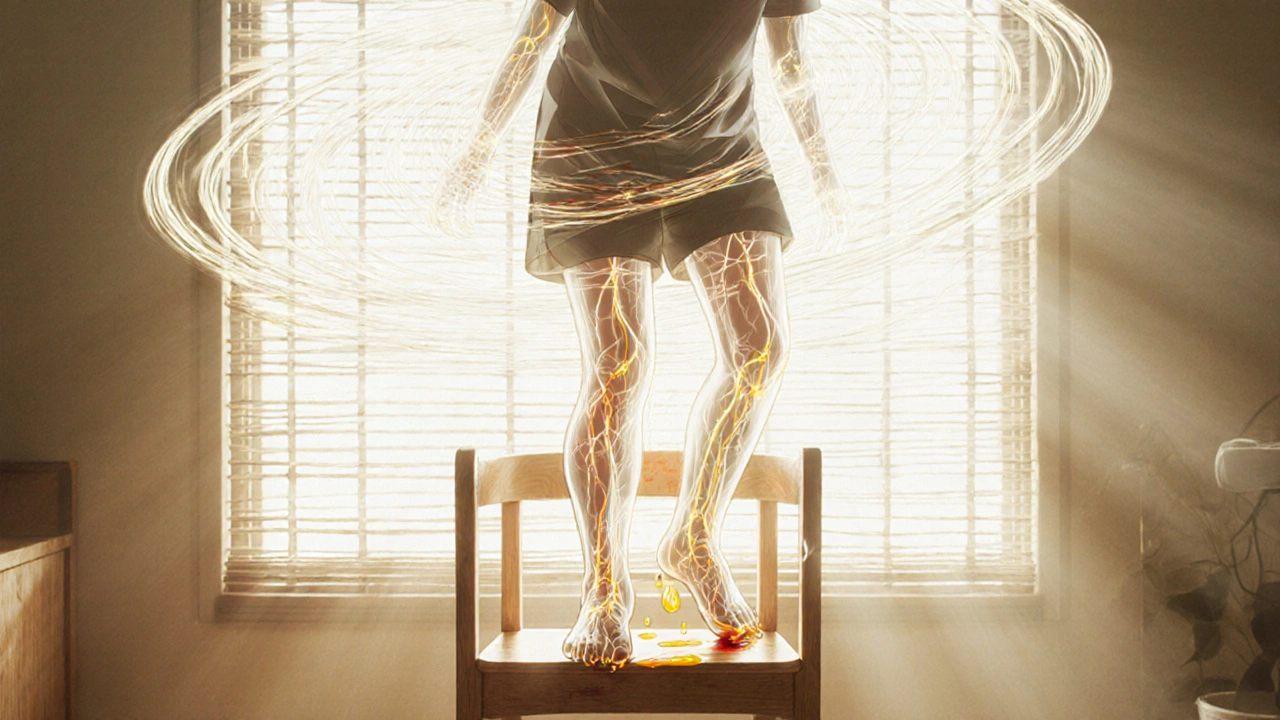When you stand up from a chair, your body should automatically adjust your blood pressure to keep you from feeling dizzy or fainting. For people with autonomic neuropathy, that automatic response breaks down. The nerves that control your heart rate, blood pressure, digestion, and other invisible bodily functions get damaged-often silently-and suddenly, simple actions like standing, eating, or walking can become dangerous or exhausting.
What Happens When Your Autonomic Nerves Fail
The autonomic nervous system runs your body’s background processes: heartbeat, breathing, digestion, sweating, and blood pressure control. It works without you thinking about it. Autonomic neuropathy damages these nerves, mostly due to long-term high blood sugar in diabetes. About 85-90% of cases are linked to diabetes, according to the American Diabetes Association. But it can also come from autoimmune diseases, chemotherapy, Parkinson’s, or even viral infections like Guillain-Barré.What makes this condition so tricky is that early on, many people feel nothing. No pain. No tingling. Just a slow decline in how well their body manages basic functions. By the time symptoms show up, the nerve damage is often advanced. Studies show that while up to 70% of diabetics have autonomic nerve damage when tested, only about 20% report symptoms. That means thousands go undiagnosed for years.
Why Standing Up Can Make You Pass Out
One of the most dangerous and common symptoms is orthostatic hypotension-your blood pressure crashes when you stand. The definition is simple: a drop of 20 mmHg in systolic pressure or 10 mmHg in diastolic within three minutes of standing. In severe cases, systolic pressure can plunge 35 points or more. That’s not just dizziness. It’s blacking out, falling, hitting your head, or even having a heart event.Why does this happen? Your sympathetic nervous system should tighten blood vessels and speed up your heart when you stand. But with autonomic neuropathy, those signals don’t get through. Blood pools in your legs, your heart doesn’t compensate, and your brain gets starved of oxygen. A 2021 study of 450 patients found that 68% had symptomatic low blood pressure during standing tests, and 42% had episodes of near-fainting at least once a week.
Some people don’t get low blood pressure-they get a racing heart instead. That’s Postural Orthostatic Tachycardia Syndrome, or POTS. It’s not the same as classic autonomic neuropathy, but the two often overlap. In POTS, your heart jumps by 30 beats per minute or more when you stand, even if your blood pressure stays normal. It’s exhausting. People describe it as feeling like they’ve run a marathon just from walking to the kitchen.
When Your Stomach Stops Working
While blood pressure crashes grab attention, gastrointestinal symptoms are just as disabling-and far more common than most realize. Up to 55% of people with autonomic neuropathy have digestive issues. The most well-known is gastroparesis: your stomach doesn’t empty properly. Food sits there for hours, bloating you, making you nauseous, and vomiting up undigested meals from the day before.Studies show 30% of diabetic autonomic neuropathy patients have gastroparesis. In severe cases, 78% vomit at night, and 45% do it daily. It’s not just discomfort-it’s malnutrition, dehydration, and constant fear of eating. One patient described it as “eating and waiting for the bomb to go off.”
Constipation is even more widespread-60% of patients have it. Bowel movements drop from a normal 4-5 times a week to just 1 or 2. Meanwhile, 25% get diarrhea, often at night. Some experience both: alternating constipation and diarrhea. That’s because nerve damage messes with the timing and coordination of the whole gut.
Many also develop small intestinal bacterial overgrowth (SIBO). When food sits too long in the intestines, bacteria feast on it and produce gas, bloating, and loose stools. One study found SIBO in 52% of autonomic neuropathy patients with GI symptoms-versus just 15% in healthy people.

How Doctors Diagnose It
There’s no single blood test for autonomic neuropathy. Diagnosis relies on recognizing patterns and running specific tests.For blood pressure issues, the 10-minute active stand test is the first step. You lie down for 5 minutes, then stand. Your blood pressure and heart rate are measured every minute. A drop of 20/10 mmHg confirms orthostatic hypotension. Heart rate variability during deep breathing is another key test-if your heart doesn’t speed up when you inhale and slow down when you exhale, your autonomic nerves aren’t working right.
For GI problems, gastric emptying scintigraphy is the gold standard. You eat a meal with a tiny bit of radioactive tracer, then get scanned over 4 hours. If more than 10% of the meal is still in your stomach at the 4-hour mark, you have gastroparesis. Newer tests like the wireless motility capsule are now used too-they’re less invasive and just as accurate.
Doctors also use questionnaires like COMPASS-31, which scores symptoms from 0 to 100. A score above 30 means significant autonomic dysfunction. These tools help track progress and show doctors how much your daily life is affected.
Treatment: What Actually Works
There’s no cure for autonomic neuropathy, but symptoms can be managed. The goal is to improve function and prevent complications.For low blood pressure, fludrocortisone helps your body hold onto salt and water, increasing blood volume. But it can cause high blood pressure when lying down-a dangerous side effect. Midodrine tightens blood vessels and helps keep pressure up when standing. It works for 70% of people, but you have to take it three times a day and never within 4 hours of bedtime, or you’ll wake up with a pounding headache from elevated pressure.
For POTS, ivabradine slows the heart rate without lowering blood pressure. It’s not a cure, but for many, it’s life-changing. One patient said, “I went from being bedridden to walking my dog again.”
For gastroparesis, metoclopramide was once the go-to drug. But it carries a black box warning for irreversible movement disorders after 12 weeks. Erythromycin works short-term, but the body quickly builds tolerance. Now, pyridostigmine is becoming the preferred choice-it improves symptoms in 55% of patients with fewer risks.
Non-drug approaches are just as important. Eating six small meals a day instead of three large ones helps. Cutting fat under 25 grams and fiber under 10 grams per day reduces bloating and delays. Compression stockings (30-40 mmHg) or abdominal binders can reduce blood pooling and cut orthostatic symptoms by 35-40%. Drinking more water and adding salt (if your kidneys are okay) helps maintain blood volume.

The Real Cost: Life Beyond Symptoms
This isn’t just about physical symptoms. It’s about losing your independence. People with severe autonomic neuropathy report 78% work disability. Many can’t stand long enough to cook, shop, or even shower without resting. Social life collapses. One patient on Reddit said, “I used to love brunch. Now I can’t go out because I don’t know if I’ll vomit or faint.”“Brain fog” is common during blood pressure drops-difficulty thinking, speaking, or remembering. It’s not anxiety. It’s your brain not getting enough blood. Patients describe it as “a thick fog rolling in when I stand.”
Diagnosis takes years. On average, people see three doctors over 4.7 years before getting the right answer. Many are told it’s “stress” or “anxiety.” That delay worsens outcomes. The longer nerve damage goes untreated, the harder it is to recover function.
What’s Changing in 2025
New guidelines are coming. In 2025, the American College of Cardiology will lower the diagnostic threshold for orthostatic hypotension from a 20 mmHg drop to 15 mmHg. That means earlier detection-before fainting spells happen. The American Diabetes Association now recommends annual screening for anyone with diabetes longer than 7 years. That could catch half a million new cases.Researchers are also testing fecal transplants for GI symptoms. Early results show 40% improvement in quality of life after six months. Blood tests measuring neurofilament light chain-a protein released when nerves are damaged-may soon let doctors spot autonomic neuropathy before symptoms appear.
Despite progress, life expectancy still drops by 8.2 years for those with severe autonomic neuropathy. That’s why early detection and aggressive symptom control aren’t optional. They’re essential.
Can autonomic neuropathy be reversed?
Once nerve damage occurs, it rarely reverses completely. But early intervention can stop it from getting worse. Tight blood sugar control in diabetics, stopping toxic exposures, and managing autoimmune conditions can preserve remaining nerve function. Some patients regain partial function with aggressive treatment, especially if caught early.
Is autonomic neuropathy only caused by diabetes?
No. While diabetes causes 85-90% of cases, other triggers include autoimmune diseases like autoimmune autonomic ganglionopathy, chemotherapy drugs such as vincristine, viral infections, Parkinson’s disease, and multiple system atrophy. Even severe alcohol abuse can damage autonomic nerves.
Why do I feel fine lying down but terrible when I stand?
Your autonomic nerves normally adjust blood pressure and heart rate when you change positions. When those nerves are damaged, your body can’t respond to gravity. Blood pools in your legs, your heart doesn’t speed up enough, and your brain gets less oxygen. That’s why you feel dizzy, blurry, or faint only when upright.
Can diet really help with gastroparesis?
Yes. A low-fat, low-fiber diet reduces stomach workload and speeds emptying. Eating six small meals instead of three large ones prevents overloading the stomach. Avoiding carbonated drinks and lying down after meals also helps. One study showed 60% of patients cut vomiting episodes in half with dietary changes alone.
Are compression garments really effective?
Yes. Compression stockings (30-40 mmHg) and abdominal binders reduce blood pooling in the legs and abdomen. A 2022 Mayo Clinic trial showed a 40% reduction in orthostatic symptoms. They’re inexpensive, non-drug, and safe-making them a first-line recommendation for many patients.
How do I know if I have autonomic neuropathy or just anxiety?
Anxiety causes similar symptoms-racing heart, dizziness, nausea-but they’re usually triggered by stress and improve with relaxation. Autonomic neuropathy symptoms happen regardless of mood, often during routine activities like standing or eating. Objective tests like tilt-table testing, heart rate variability, and gastric emptying scans can confirm the diagnosis. If you’ve been told it’s anxiety but tests are normal, ask for autonomic screening.
What to Do Next
If you have diabetes and feel dizzy when standing, have frequent nausea or vomiting after meals, or experience unexplained constipation or diarrhea, talk to your doctor about autonomic neuropathy. Don’t wait for symptoms to worsen. Request a 10-minute active stand test and ask about COMPASS-31 scoring.Keep a symptom journal: note when you feel faint, how often you vomit, your bowel habits, and what triggers it. This helps doctors spot patterns. Bring it to your appointment.
Start simple: wear compression stockings, eat smaller meals, drink more water, and avoid standing still for long periods. These steps can make a real difference while you wait for a diagnosis.
Autonomic neuropathy is not a death sentence-but it is a wake-up call. The sooner you act, the more of your life you can keep.


Let’s be real-this post is one of the few that actually breaks down autonomic neuropathy without sugarcoating it. Most docs just say 'drink more water' and call it a day. The 68% stat on orthostatic hypotension? That’s not anecdotal. I’ve seen it in my own family. My uncle went from hiking weekends to needing a wheelchair because no one took his dizziness seriously until he cracked his skull on the kitchen tile. The COMPASS-31 score? That’s the missing link in clinical practice. Why aren’t we using it as a routine screening tool like HbA1c?
And the SIBO connection? 52% in patients vs 15% in healthy people? That’s not coincidence. It’s systemic. The gut-brain axis isn’t just a buzzword-it’s the backbone of why GI symptoms are so pervasive. We need more research on microbiome modulation, not just another round of metoclopramide prescriptions.
ok so like… autonomic neuropathy is just diabetes being lazy right? like why are we even talking about this like its some new fad disease. its just bad sugar control. if you eat healthy you dont get this. period. also why are we paying for all these fancy tests when you could just like… not be fat? 🤷♀️
As a neurologist who specializes in autonomic disorders, I’ve seen this play out in over 500 patients. The key takeaway? Early detection saves function. That 15 mmHg threshold change in 2025? Huge. I’ve had patients who were told ‘it’s anxiety’ for 6 years. By then, their heart rate variability was toast. Compression stockings? Non-negotiable. I hand out free ones at my clinic. They’re cheap, effective, and don’t require a prescription. And yes-pyridostigmine is replacing metoclopramide for good reason. Fewer side effects, better outcomes. If you’re reading this and have diabetes? Get screened. Don’t wait for fainting.
Also-fecal transplants for GI symptoms? I’m cautiously excited. Early data is promising. We’re not talking about ‘miracle cures’-we’re talking about restoring motility where meds fail. This is the future.
Man i had this for years and no one believed me. now i wear my compression socks every day and drink salt water in the mornin. i can actually walk to the fridge without feelin like i’m gonna pass out. its not a cure but it’s a lifehack. thanks for the post 😊
It is deeply irresponsible to suggest that dietary modifications alone can manage gastroparesis without medical supervision. The claim that ‘60% of patients cut vomiting episodes in half with dietary changes alone’ is statistically misleading without context regarding baseline severity, sample size, or duration of intervention. This post dangerously oversimplifies a complex neurological condition into a lifestyle blog. Autonomic neuropathy is not a matter of ‘eating smaller meals’-it is a progressive, systemic neurodegenerative process requiring multidisciplinary care. Please stop normalizing medical misinformation.
The real issue is the medical system ignores this until you collapse. I got diagnosed after I passed out in a Walmart. No one tests for this. No one cares. Just give you more painkillers. The fact that 85% of cases are from diabetes means we should be screening every diabetic over 40. But we don’t. Because it’s cheaper to let people fall and break hips.
I’ve had this for 8 years. The worst part isn’t the fainting or the nausea. It’s how people think you’re just ‘tired’ or ‘overreacting.’ I had a coworker tell me to ‘just drink more coffee.’ I didn’t say anything. But I stopped going to lunch with them. You don’t have to understand it. Just believe me when I say it’s real.
As someone who grew up in South Africa and now lives in the U.S., I’ve seen how differently this condition is treated. In Cape Town, my cousin got diagnosed because her doctor knew to test for autonomic dysfunction after she started collapsing after church. Here? I waited 5 years. The system is broken. But the science? Solid. The fact that fecal transplants are being tested? That’s African traditional medicine meeting Western science. We need more of that cross-cultural collaboration. Not just for autonomic neuropathy-for all chronic illnesses that get dismissed as ‘psychosomatic.’
I’m 32 and was just diagnosed. I’ve been reading everything I can. But I’m confused-why does POTS overlap so much with autonomic neuropathy but isn’t classified the same? Are they on a spectrum? Is POTS a subtype or a cousin? And why is ivabradine not FDA-approved for POTS? It’s not off-label use if it’s the most effective thing we’ve got. Also-what’s the long-term prognosis if you catch it early? Is there hope for partial recovery? I need to know if I’ll ever be able to walk my dog again without my heart pounding like a drum.
Let me tell you something. This isn’t just diabetes or ‘bad nerves.’ This is all part of the Big Pharma agenda. They don’t want you to know that autonomic neuropathy is caused by glyphosate in your food and fluoride in the water. The ‘tests’ they use? They’re designed to keep you dependent on drugs like midodrine. The real cure? Cold exposure therapy and organic apple cider vinegar. I’ve been doing it for 2 years. My symptoms are 90% gone. But the doctors won’t tell you this because they get paid to keep you sick. Google ‘autonomic neuropathy glyphosate’ and you’ll see the truth. They’re hiding it.
Wow. Another ‘educational’ post that reads like a pharmaceutical brochure. ‘Midodrine works for 70%’? Who funded that study? ‘Fecal transplants show 40% improvement’? That’s not a cure, that’s a pilot with 12 participants. This isn’t science-it’s clickbait wrapped in medical jargon. And let’s not forget the 8.2-year life expectancy drop. That’s not a wake-up call. That’s a death sentence with a side of optimism. I’m tired of people treating this like it’s just another ‘manageable condition.’ It’s not. It’s a slow, invisible unraveling. And the system is doing nothing.
nah bro this is just anxiety. i had the same symptoms. i stopped drinking soda and now i’m fine. also why do people think they need all these tests? just stand up slower. lol
also i saw a guy on tiktok who said he cured it with CBD oil. maybe that’s the real answer 🤔
Thank you for writing this. I’ve been trying to explain this to my mom for years. She thinks I’m just being dramatic. But now I can just send her this. I started wearing my compression socks and drinking salt water. I still have bad days, but I’m not hiding anymore. You’re not alone. I’m here if you need to vent.
I’m curious-what’s the data on autonomic neuropathy in non-diabetic patients? The post mentions autoimmune and chemo causes, but are there any longitudinal studies tracking progression? Especially in cases triggered by viral infections like Long COVID? I’ve seen a few case reports, but nothing large-scale. Is there a registry I can access?
Correction: The American College of Cardiology has not yet officially lowered the diagnostic threshold for orthostatic hypotension to 15 mmHg as of 2025. The proposed guideline update is still under public review and has not been ratified. This post contains an inaccurate claim that could mislead clinicians and patients. Please verify sources before disseminating medical information.